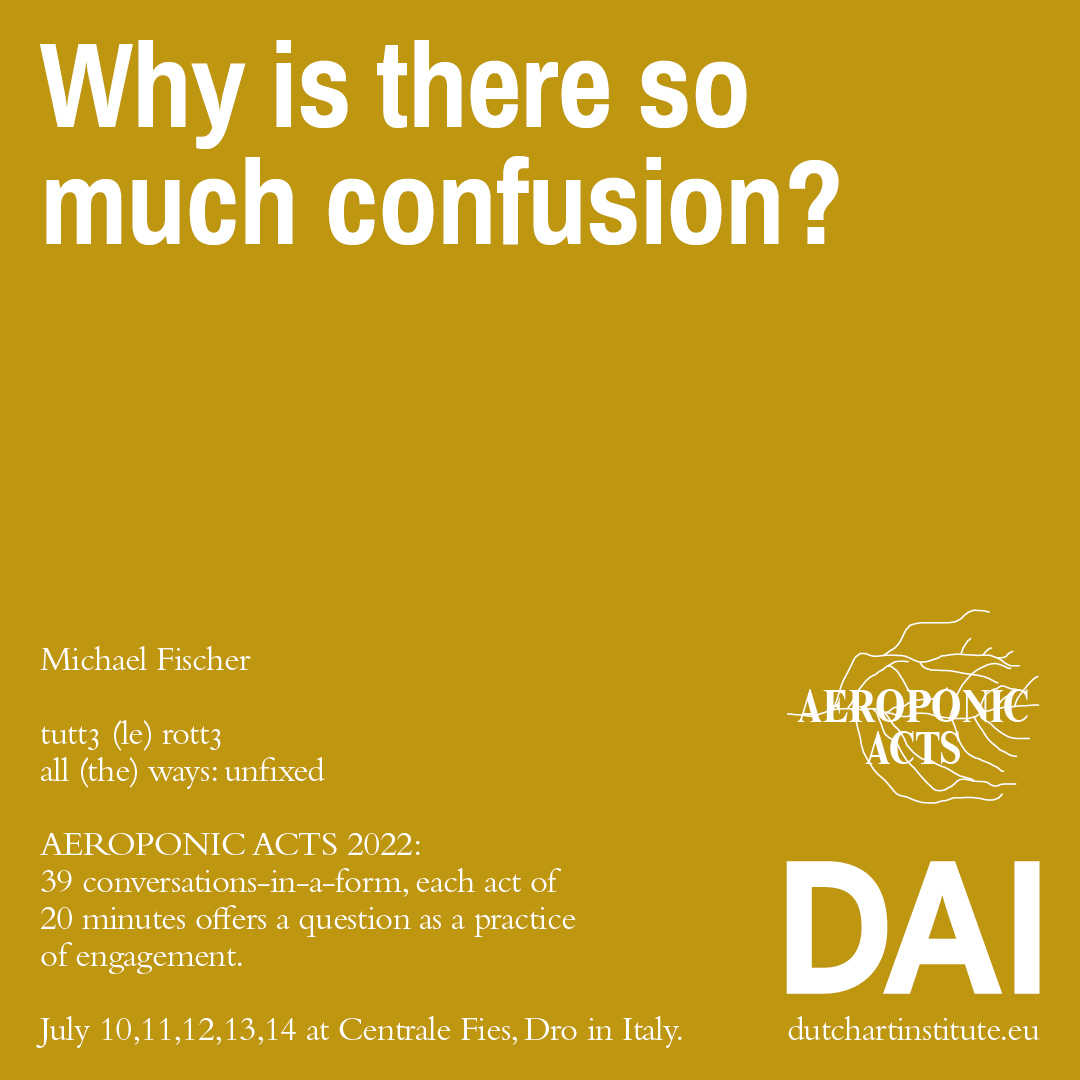Michael Fischer: Mnemonic Palaces, Transpositioning Tails and Memory Cards
‘Aeroponic’ – root systems nourished by air – Acts is the name given to the nomadic Dutch Art Institute’s final Kitchen presentations. Each participant addresses one question, as a practice of engagement.
Here you will find the documentation of Michael Fischer's presentation as filmed by Baha Görkem Yalım. The written report is by Hubert Gromny and it includes a summary of the comments by esteemed guest respondents.
Mnemonic Palaces, Transpositioning Tails and Memory Cards
Michael's question: Why is there so much confusion?
Michael's introduction: Why is there so much confusion? So much terror around us. So little time to speak, So little space to breathe, So little time to be weak. So little space to be, so little time for every need. Why is there so much confusion?
Hubert's report: The audience enters a bright space where different objects are distributed in forms of “islands” or “stations”. There are prints with text, images, photographs and tarot cards. Derek DiFabio and Miel Farraez are walking around the space swinging colorful pipes and creating a sound. Michael is present and sings in a joyful manner. He wears violet ribbon tangled around his ankle and blue shirt with many holes. In the corner a small toy resembling a radio or tape player with an attached microphone is located on top of colorful carpets. The audience creates clusters sitting around the “islands''. Michael picks up the radio and the sound of crickets from the speakers fills the room. He begins to speak: “Welcome to the care place…” and continues whispering to the toy-microphone. Michael joins one circle of the audience and starts to explain the images and photographs, which allows him to evoke memories of different DAI weeks. In a childish-like narrative he speaks about the Netherlands and the unusual things he noticed about this place. He puts on a golden jacket and recalls the DAI week in PAF and moves to picking tarot cards and relating them to the specific moments of the DAI program. Maoyi (Peixuan Qiu) and Iga Świeściak stand up, take another violet ribbon and use it to play while balancing their bodies. Michael continues telling stories and engaging with the audience and respondents. He asks Derek and Miel to stop swinging sound-making pipes and lower the volume of the speakers, then starts humming and singing softly. Adriana Leanza stands up and joins Michael in singing “Nothing to be afraid of…”. More people are standing up, walking around the space and singing together. Fading out of the song marks the end of the performance.
Chiara Figone reflected on the way the audience was invited to participate in the performance and on the confusion the piece generated. The work created many different layers to be read: printed materials, tarot cards, movement in the space—it was difficult to use these tools and actually enter the realm of the piece. The piece was bringing individual audience members and the audience as a collective to the larger world created by Michael, at the same time this world seemed to take away some weight from the reading of images and stories. Like in the moments when tarot cards were directed to individuals, they seemed to be part of a certain world created in the piece rather than actual means for personalized readings.
Momtaza Mehri alluded to the title and spoke about patterns of memory tied within the work and revealed by Michael roaming around and unraveling his personal historiography. In a sense this was reflecting on the roaming as an educational tool essential to the DAI program, and in the performance it became a technology of memory. Momtaza described the dynamics of the piece as volatile invocations of different mythologies and clarifying what is not expected to be clarified. For example, swinging colorful pipes resembled medieval windmill deities. Another element of the performance was a comical presence and explanations of images constituting the “islands”. Momtaza noted that she initially expected much more ambiguity from the performance and was surprised by clarifications. At the same time explanations provided were not sterile and dry but embodied and personal.
Ana Teixeira Pinto spoke about the broader topic of recollection of memory in the context of intergenerational traumas and allegorical narratives. Ana pointed out that the presentation was an interesting attempt to create a different technology of recollection as opposed to the popular view of the memory as drawers (which one can open and reach out to items of the past). This association led Ana to speak about the concept of the container both as a metaphor for the memory but also as a literal container used for transportation of goods. The shipping container was mentioned within the presentation, while speaking about Dutch harbors. Evoking work of Alan Sekula on standardized, maritime transportation system Ana spoke about the broader question of mnemonic palaces as systems of standardization, which render certain things to be seen, unseen, forgotten and retrievable. The tarot intersects interestingly with this theme, bringing the notion of opacity, which could be compared with the opacity of the transportation system—when the content of the container, its destination and purpose remain unknown. Tarot, existing in Europe since 13t-14th century, became popularized in the 18th century, which corresponds with the emergence of a global market and an unstable view of the world so vast that impossible to be read. The piece hinted at an interesting connection between divination practices and strategies of prediction of market fluctuation.
Michael Fischer's "Mnemonic Palaces, Transpositioning Tails and Memory Cards" was presented before live audience at the Centrale Fies, Dro, Italy on July 13th.
Find the overview of all 24 AEROPONIC ACTS 2022 here: tuttə (le) rottə - all (the) ways: unfixed


